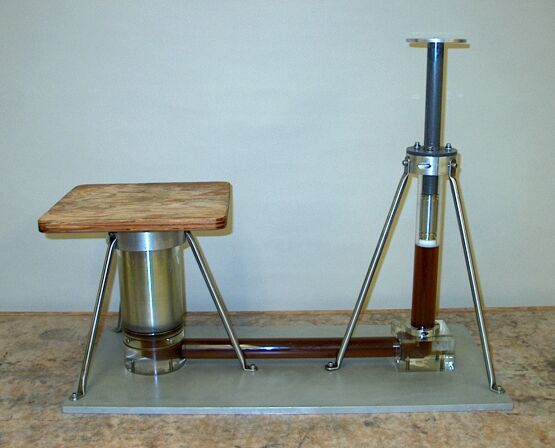

Two vertical transparent cylinders, 4.5″ (11 cm) i.d. and 1.5″ (3.8 cm) i.d., are connected to each other by a horizontal transparent plastic tube. The piston inside the 4.5″-diameter cylinder has a wooden platform attached to it, on which a person can stand. The piston inside the 1.5″-diameter cylinder has a disc at the top, on which you can press down. As you press down on the disc, you raise the platform on the larger cylinder. The 3:1 ratio in cylinder diameters gives a 9:1 ratio in the areas of the piston faces. For a given pressure, then, the total force on the large piston is nine times that on the small piston, as is the volume displaced per unit of travel. This provides a mechanical advantage that allows you easily to lift a person. For example, if a person who weighs 81 kg (780 N, 180 pounds) stands on the platform, then applying a force to the disc of just over 87 N, which corresponds to the weight of a 9-kg mass, or about 20 pounds, is enough to lift him. The price you pay for this mechanical advantage is that for every inch you raise the platform, you must press the disc down nine inches.
The basis of this demonstration is Pascal’s principle (see demonstration 36.27 -- Pascal’s principle), which states that pressure applied to an enclosed fluid is transmitted undiminished to every portion of the fluid and to the walls of the containing vessel. This demonstration shows the application of this principle to the construction of a type of machine that uses it to provide a mechanical advantage, in this case to lift someone with significantly less effort than would otherwise be required to do so. If we place a mass M on the wooden platform, its weight is Mg, which, if we neglect friction and the weight of the platform and piston themselves, is the downward force on the piston. As the piston presses down on the fluid inside the lift, this force is distributed over the area of the piston face, A, which results in a pressure being exerted on the fluid, of Mg/A. In SI units, this is expressed as N/m2, which as a single unit is called the pascal (Pa). The area of the piston face is 16 square inches, which equals 100 square centimeters, or 0.010 square meters. If a 50-kg person steps on the platform, the force is (50 kg)(9.8 m/s2) = 490 N, and the resulting pressure is 490 N/0.010 m2, or 4.9 × 104 Pa. A 50-kg person weighs 110 pounds, so in English units, this is a pressure of 110 lb/16 in2, or 6.9 psi. The face of the small piston has an area of 1.8 in2, which equals 11 cm2, or 1.1× 10-3 m2, so the upward force on it that results from a 50-kg person standing on the lift is (4.9 × 104 Pa)(1.1× 10-3 m2) = 54 N. This is the force exerted by a 5.5-kg mass, or one that weighs 12 pounds, and, as noted above, is one-ninth that exerted on the large piston. As also noted above, since the area of the large piston is nine times that of the small piston, in moving a given distance, it displaces nine times the volume that the small piston would displace if moved over the same distance. To lift the 50-kg person by, say, 2 cm, then, you must press down on the small piston with just greater than the weight exerted by a 5.5-kg mass (54 N), and move it down by 18 cm.